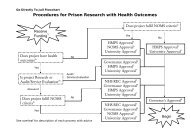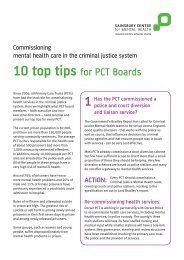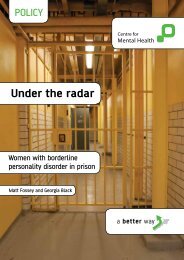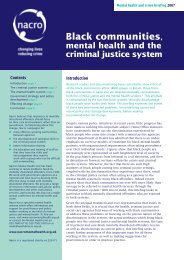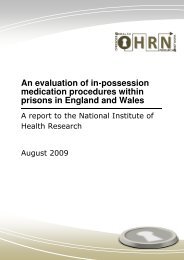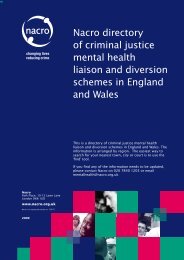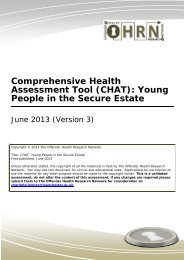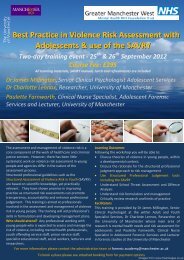Engendering Justice - from Policy to Practice - The Fawcett Society
Engendering Justice - from Policy to Practice - The Fawcett Society
Engendering Justice - from Policy to Practice - The Fawcett Society
- No tags were found...
Create successful ePaper yourself
Turn your PDF publications into a flip-book with our unique Google optimized e-Paper software.
Figure 3: Female Reoffending Rate by Length of Cus<strong>to</strong>dial Sentence 2000-2006 29Source: Statistics on Women and the Criminal <strong>Justice</strong> System, Ministry of <strong>Justice</strong>, January 2009, p.61<strong>The</strong> Judiciary and the Sentencing of Female OffendersOf course it is right that the judiciary should jealouslyguard its independence <strong>from</strong> Government and theexecutive. But that does not mean that it should ignorethe concerns expressed by others about the trends forwhich its decisions are responsible. <strong>The</strong> family justicesystem is asking itself whether it is indeed unjust <strong>to</strong>fathers. <strong>The</strong> criminal justice system could also ask itselfwhether it is indeed unjust <strong>to</strong> women. 26(Lady <strong>Justice</strong> Brenda Hale DBE, Lord of Appeal inOrdinary, December 2005)Since its inception the Commission has drawn attention <strong>to</strong>the fact that: <strong>to</strong>o many women are being imprisoned onshort sentences for non-violent crime; there is an over-useof remand for female defendants; and there are <strong>to</strong>o manyforeign national women in prison, particularly those servinglong sentences for drug-smuggling offences. Much ofthe rise in the female prison population can be attributed<strong>to</strong> a significant increase in the severity of sentencing. Forexample, in 1996, 10 percent of women convicted of anindictable offence were sent <strong>to</strong> prison. While in 2006, 15percent of women were. 27 Short sentences continue <strong>to</strong>have a devastating effect on the lives of women whileleading <strong>to</strong> increased rates of reoffending. As a prisonworker commented <strong>to</strong> the Commission, “Getting sentenced<strong>to</strong> four weeks for driving whilst disqualified, what does itachieve” 28A lack of information available about sentencing practicesmakes it very difficult for any analysis of the reasons behindthis increase in the severity of sentencing. This dearthof information is an issue of particular concern <strong>to</strong> theCommission, resulting in limited knowledge as <strong>to</strong> the effec<strong>to</strong>f sentencing guidelines or trends in sentencing in relation<strong>to</strong> female offenders.<strong>The</strong> Commission understands that the new SentencingCouncil, proposed in the Coroners and <strong>Justice</strong> Bill, willbe coordinating the collection of data on sentencing.Information on gender, ethnicity, previous convictions,mitigating circumstances and aggravating fac<strong>to</strong>rs is crucialin the long term in order <strong>to</strong> understand sentencingpractices and trends. Mechanisms and resources shouldbe put in place <strong>to</strong> collect this information. However, in theshort term, the NOMS regional structure could be utilised<strong>to</strong> compile information which is currently available suchas offence type and sentencing outcome. It is crucial thatsteps are taken <strong>to</strong> collect this information and in fact, thecollection of data and the implementation of moni<strong>to</strong>ringsystems <strong>to</strong> assess the different impacts of sentences onwomen and men are necessary in order <strong>to</strong> comply withthe GED. This duty will also apply <strong>to</strong> the new SentencingCouncil.<strong>The</strong> Commission has consistently recommended that theSentencing Advisory Panel should conduct a thematicreview in<strong>to</strong> women offenders. However, the Commissionwas <strong>to</strong>ld by the Sentencing Advisory Panel, that a lackof resources and the need <strong>to</strong> prepare guidelines for newlegislation, had led <strong>to</strong> an inability <strong>to</strong> conduct research onthis issue. <strong>The</strong> proposed Sentencing Council must besufficiently resourced <strong>to</strong> enable such research, includingrecent trends in sentencing and whether the availablerequirements of the community order are effectively meetingthe needs of women offenders.Page 25




